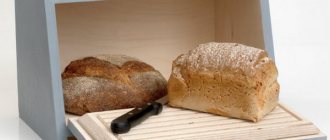The shelf life of baked goods is short. So, how to store bread so that it does not go stale or moldy?
Rye is stored for 36 hours, wheat - for a day. Small items up to 200 grams – 16 hours. To preserve the nutritional and taste properties of baked goods, it is recommended to maintain an air humidity of 75% and a temperature of 18-25 C.
Bread that goes on sale is accompanied by documents indicating the date and hour of baking. During storage, processes occur in flour products that deteriorate the quality and taste. The product loses moisture and dries out.
Where to store bread? Traditional way - bread box
It is convenient to keep baked goods in a bread box. It is desirable that it consist of two sections. Bread containers are made from different materials: ceramics, plastic, metal, wood.
The experts' opinion is clear. The best material for making bread bins is considered to be wood of the highest quality.
To increase the freshness of the loaves, place it in a dry, bright place, further from the sink.
Rules for caring for a wooden container:
- Once a week, wipe surfaces with a weak solution of vinegar;
- Wash the product in warm water 2 times a week and dry thoroughly;
- Ventilate the kitchen regularly.
Following these tips will help avoid mold and keep the product fresh and appetizing.
Why does bread mold in the bread bin?
Causes of mold:
- Poor quality flour: violation of storage standards, contamination with harmful bacteria. In a warm and humid kitchen, mold grows instantly.
- Dirty bread bin: not washed after spoiled product. Not completely dried.
- Loaves of a certain manufacturer: buy at another bakery.
- The sanitary standards for baking and the contents of the composition were violated.
Frequent airing of the kitchen and lemon peels placed in a container overnight will help keep the bread fresh.
What material to use for storing bread
The product will stay fresh longer if you choose the right storage container. Natural fabric or paper copes well with this function. Plastic, polyethylene or foil also preserve the freshness of bread well. However, when using them, take care of ventilation inside, since condensation appears on the inner surface of such materials.
Convenient storage in fabric and polyethylene
Bread and bakery products are stored in different ways. Some housewives prefer fabric bags, others prefer plastic bags.
In addition to ordinary bags, pieces of flax or canvas are used. Wrap it up and put it in the closet. This keeps the product fresh and fluffy for 3-4 days. Then it becomes stale, but does not lose its taste.
It is recommended to wash the fabric or storage bag 2-3 times a month. Use unscented soap and do not use powders with fragrances. Additives in detergents affect the quality of the product.
Plastic bags keep bread loaves fresh for 5 days. It is important that the loaf is clean and dry. A polyethylene bag retains moisture and prevents the loaf from becoming stale and dry out.
But at the same time, the material increases the accumulation of condensation. High humidity creates an environment inside the bag that is favorable for the growth of bacteria.
That's why the bag needs holes. You can pierce the holes with a fork or knife.
The factory packaging initially contains round holes. Air enters and prevents the appearance of wet spots and mold.
How to restore freshness to a stale product
In order to restore freshness to stale bread, you can use the following tips:
- Sprinkle clean water on the loaf, put it in the oven for a few minutes at a temperature of 100-120°C;
- put the product cut into pieces in a colander, cover with a lid and hold over water brought to a boil for 2-3 minutes;
- warm up the loaf, use a thermos or thermal mug with a wide neck for further storage.
Dried bread can also be used as crackers. In this form, it will be useful when losing weight to remove waste and toxins from the body.
Bread is a valuable universal product with a short shelf life. In order to keep it fresh for as long as possible, it is important to responsibly select materials for packaging and other storage conditions. The shelf life of bread will also vary depending on its type.
How do you prefer to store baked goods? Share your experience in the comments, repost.
Secrets of long-term storage
– Bread will be tasty and healthy for a long time if you follow these tips:
– Place peeled potatoes or apple slices in a container. These products absorb excess moisture and prevent the loaves from hardening.
– A hot, freshly baked loaf should be cooled. Leave for 3 hours, pack.
– Store the rolls in closed containers and pans in additional packaging.
– The old method recommends: first divide the loaf into two parts. Cut the required number of pieces from the center. Remove the rest by pressing with the cuts.
– Keep the product in bags containing 3 layers: fabric inside and outside, plastic between them. the product will remain soft for 3-4 days.
– Cut and sew the bags. Soak in saline solution. Dry without rinsing with water.
To choose the right storage method, try them all and settle on the one that suits you.
Why does bread spoil quickly?
Regardless of the storage method, bread will begin to spoil after a while. The main reason for this is microorganisms in the environment. The process is accelerated if the bread is made from low-quality raw materials.
A properly prepared bun can be stored at home for at least 3 days, then it becomes stale and dries out. Such bread can become moldy only 6-8 days after production, depending on the type of flour.
If mold has formed on the bread a couple of days after purchase, it means that it was baked incorrectly or was incorrectly stored in too airtight packaging or in high humidity.
To prevent bread from spoiling for a long time, manufacturers often add acidifiers and other additives to it.
Is it possible to store baked goods in the refrigerator: salvation or mistake?
According to housewives, flour products remain fresh in the refrigerator for 6-7 days.
To do this, it is advisable to follow the rules:
1. Remember that flour absorbs the odors of other foods. Therefore, it is recommended to put baked goods in the refrigerator in a container or bag.
2. It is forbidden to store bread that has not cooled down in the refrigerator compartment. Moisture collects on the walls of the package and the bun spoils.
3. Bread products that are beginning to mold should not be placed in the refrigerator. A lower temperature will not prevent the process. In addition, the pathogenic fungus will spread to the rest of the food.
Low temperature is considered a negative factor of this method. Chilled bread seems tasteless and loses its smell. The bun has to be reheated before eating. Many people don’t like the fact that it dries and hardens because the moisture evaporates faster than at the temperature in the room. And they choose a freezer.
Useful Tricks
It often happens that a whole loaf gets wrapped up or dries out. To avoid throwing away the product, you can try the following:
- sprinkle the loaf with purified water and place it in an oven preheated to 150 °C;
- put the bread in a colander and place it over boiling water, covering with a lid;
- heat the loaf in the microwave at maximum power (3-5 minutes) with a small container filled with water;
- prepare the casserole: cut the stale bread into small pieces. Pour in the egg-milk mixture and place in the oven.
Bread can rightfully be called the most popular product in stores. In order to fully enjoy its taste and not waste money, you need to know what kind of bread and how to store it correctly.
How to properly store bread in the freezer
Sometimes it becomes necessary to keep the loaves edible for 2 weeks or more. This is possible using a freezer.
A product frozen according to instructions and properly thawed is no different from a freshly baked product. Retains moisture, remains appetizing and soft.
Cut the bun into portions. Place in paper and plastic bag. Remove the air from the packaging and place in the freezer. Set the temperature to 20 C.
Stored at temperatures up to – 18 C for 3-4 months.
Thaw it indoors before eating. It will take 2 hours. Do not freeze the loaf the second time!
If you follow the storage rules, the bread will remain fresh and tasty.
Drying crackers
Crackers are one of the ways to preserve baked goods. The dried pieces are thrown into soup or borscht. If necessary, reheat by steaming.
Drying crackers at home is easy. An accessible method is oven drying:
- cut the bun into pieces;
- spread on a sheet in one layer;
- place in the oven, heated to 120-130 C;
- leave for 10 minutes;
- turn the pieces over and cook until browned, 8 minutes.
The preparation time for crackers is half an hour. For uniform drying, it is advisable to cut pieces of the same size.
Why freeze bread
You can freeze not only berries, meat, and fish. Bakery products are often subjected to this procedure. Today, many supermarkets offer fresh baked goods. Most work on semi-finished products.
When properly frozen, bread completely retains its taste and aroma. This is a great way to keep baked goods fresh for a long time. If the technology is broken, the product quickly loses its properties, becomes wet, and acquires an unpleasant odor. It cannot be stored for a long time and will definitely not bring any benefit. You can also freeze sour cream and even birch sap.
Do you store bread in the freezer?
Not really
Why freeze bread:
- prolongation of freshness. Rare, expensive, tasty types of bread are easier to store in the freezer. Under room conditions, the product changes the very next day;
- save the surplus. It’s a pity to throw it away, sometimes there’s no one to give it to;
- convenient supplies. Freezing will help if you forgot to buy some bread after work, you returned from vacation, the store near your house is not open, or guests suddenly came.
You can freeze white, dark bread, buns, baguettes, and any other baked goods. The shelf life reaches six months. It is advisable to use it within a month. Defrost in an oven, double boiler, or at room conditions.
Black and white - together or apart?
Grey, black, white: each species has its own individual microflora. And loaves of different types, if placed together, begin to quickly deteriorate.
It is recommended to keep white and black bread apart or pack it in separate bags.
The reasons for the impossibility of storing different varieties together is that white and dark have different amounts of water in the mass of flour. Black contains 80% water, white - about 60%.
In addition, the rich smell of black is absorbed by white loaves.
If wet and moldy spots appear on the pieces, then they are not suitable for food!
Is the freezer suitable for this?
The freezer is best for storing baked goods.
Sub-zero temperatures do not allow yeast to interact with other products, so the smell and taste will remain unchanged. Cold also prevents the evaporation of moisture, which has a beneficial effect on the quality of the product. It is believed that bread can remain fresh in the freezer for three to five months , but a number of conditions must be observed so as not to spoil it.
How to keep it in the freezer?
- The loaf should be divided into portions needed for one meal, as re-freezing bread is not recommended.
- The product should be tightly wrapped in foil, cling film, polypropylene packaging or parchment.
- Remove the packaging only after complete defrosting.
- It is better to freeze fresh bread so that you can get the same bread later (stale bread will remain stale even after freezing).
- Take out two hours before use, as it needs to be defrosted at room temperature.
What does SanPin say about the storage of bakery products?
The Russian Federation has established the following sanitary rules and standards for the storage of bread products:
Bread is stored in suitable rooms: light, clean, ventilated and dry. Isolated from heating devices and cold air. Mold and wet stains are not allowed on the walls.
Products are stored in open or closed containers placed on mobile racks. Shelves, trays, racks are made from materials approved by the Ministry of Health: metal, wood, plastic.
It is prohibited to store goods that differ in composition and smell in warehouses for flour products.
For shelf life, the loaves are packaged.
Shelf life of bread products:
- wheat – 3 days in packaging, 1 day without packaging;
- rye – 5 days;
- Borodinsky - 36 hours;
- wheat-rye – 4 days;
- wheat loaf – 1-3 days.
Since 2021, factory packaging for baked goods contains sorbic acid. A natural preservative protects against mold and increases the time of use.
How to recognize a delay?
To avoid buying spoiled bread, pay attention to the presentation:
- the bun should be smooth and without dents;
- take its original shape after squeezing;
- have a bready smell;
- be free of traces of mold and dark deposits.
The presence of one of the listed signs indicates that the product is expired. You can't buy or eat this.
Storage temperature of bakery products
The optimal temperature for storing buns is from 10 to 25°C. In this case, the loaves should not be left without packaging or other containers; it is best to use a bread box or cloth. Otherwise, conditions will vary depending on the type of baked product.
Wholegrain
Whole grain bread is made from sprouted wheat grains. For storage and consumption, you should choose high quality products. For example, when you purchase flour products, pay attention that the main ingredient in the composition is whole grain flour.
Whole grain bread can be stored for 2 days when opened and 3 days when packaged. Humidity should not exceed 75%, temperature should not exceed 25°C, the place should be dry and well ventilated.
Bezdrozhevoy
Yeast-free bread does not differ in storage conditions from yeast bread. However, its shelf life is up to 10 days, starting from the date of manufacture. In order for the loaf to remain soft for as long as possible, it must be wrapped in the selected material and placed in the bread bin.
Gluten-free
Gluten-free bread does not contain flour that contains gluten. This product is suitable for losing weight, switching to a healthier diet or if you are gluten intolerant.
Freezing is considered the best way to store gluten-free products. The product must be cut into slices, packaged, labeled and placed in the freezer. Before eating, just take out the required amount of bread and heat it in the microwave for 3-5 minutes.
Otrubnoy
A product containing bran, under suitable conditions, retains its nutritional properties for up to 7 days. The best ways to store bran bread are:
- wrapping in paper or plastic bag;
- placement in a bread bin.
Black and white together or separately
Different types of bread have different composition. For this reason, storage conditions and expiration dates will vary.
After one type of loaf goes bad, it will begin to absorb moisture from another. Because of this, both will become stale much earlier than expected.
If mold appears on one bun, it will most likely spread to the other. Therefore, different types of baked goods should be stored separately from each other.
Freshly baked bread
Fresh baked goods require compliance with the following storage rules:
- Ready hot bread must be removed from the mold as soon as possible, then the crust will be crispy.
- Until the loaves have cooled to room temperature, they should not be packaged.
- Use a plastic bag or breathable cloth to wrap your freshly baked loaf. If you are going to use the bread soon, just put it in the bread bin.
Bread crackers
Rusks are dried bread. Dehydrated slices can be seasoned with salt or tossed with sugar, making them a versatile snack or dessert.
Crackers at an optimal humidity level (75%) can be stored for up to 2 years from the date of manufacture. When storing crackers, you should consider some nuances:
- It is best to keep the product in a dark, ventilated place. Do not place it near fresh baked goods or fruits, as they will begin to absorb moisture and quickly deteriorate. Be sure to use storage packaging.
- Dried crackers have a longer shelf life than fried ones. If the product contains food additives, the shelf life is reduced. Snack crackers should be consumed immediately after opening the package.











